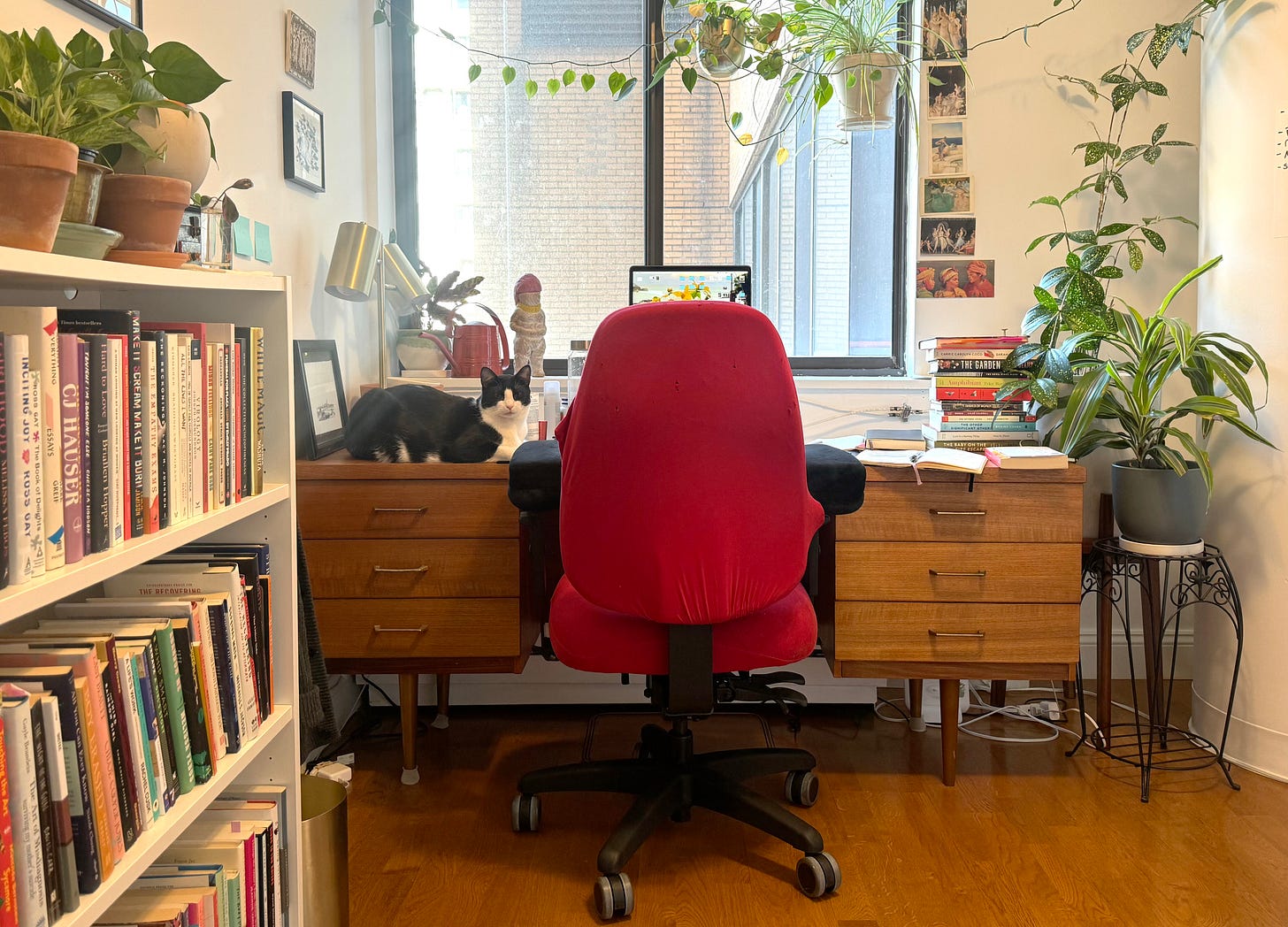Lilly Dancyger On Claiming Space For Writing
When A New Desk Is More Than Just A Desk
I no longer recall when or how I first met
but I do know I can’t remember the writing community without her. Entering the land of Facebook, Instagram, and Twitter in the days when my health was still extremely challenged wasn’t easy — but I was living in isolation (having just moved to a new state months before completely collapsing) and I knew writers were gathering there. I admired Lilly’s gorgeous prose, fierce intelligence, and fast wit. And she welcomed me with kindness and guidance.Over the years, I’ve interviewed Lilly three times: first for her incendiary anthology Burn It Down: Women Writing About Anger. And then for her breathtakingly gorgeous (and one of my favorite ever) memoir Negative Space about getting to know her deceased father through his journals, letters, artwork, and interviews with friends. Finally, Lilly was one of the six anchor interviews that launched Beyond; Lilly is a master of craft, and the insight she shares in this beautiful essay is remarkable.
Lilly’s writing has been published by Guernica, Literary Hub, The Rumpus, Longreads, Off Assignment, The Washington Post, Playboy, Rolling Stone, and more. She teaches creative nonfiction in MFA programs at Columbia University and Randolph College.
And, lucky for us, Lilly is now on Substack with
. And luckier still, Lilly has a new book out, First Love: Essays on Friendship, a tender, thoughtful exploration of the intimacies, challenges, and foreverness of female friendships. She lives in New York City with her husband, two beloved kitties, and her new desk.I was enchanted by this piece. I think you will be, too. Let me know what you think in the comments. You know I love to hear from you!
xJane
A New Desk: On Claiming Space for Writing
During the eleven years I spent writing my first book, I lived in five different apartments, with a roommate and then by myself and then with my now-husband. Through all of that time and all of those moves, I had the same small-but-sturdy wooden desk. Smaller than most desks for adults—I think it might actually have been made for children—this desk had just enough space for my laptop, a cup of coffee, and a notebook. But it was enough. The desk, with its scuffed reddish-brown varnish, fit under my loft bed, in the corridor off the kitchen, and in a cramped corner of the living room, like my writing fit into my busy life.
The reason it took over a decade to write that book was because I could only carve out little corners of time to write. I was bartending full time and trying to build a writing career one freelance article at a time. I was meeting and falling for and moving in with the person I would marry. I was going out with friends on my nights off. Some weeks I didn’t write at all. But the little red desk was always there, tucked in some corner, waiting for me to come back to it when I could. It became a symbol of my determination to make it work; to finish my book despite all the other demands on my time.
That book was published, finally, during the part of the pandemic when people interacted with each other almost exclusively on the internet, so not only did I write the whole book sitting at that desk, I also did my whole book tour—on Zoom—at that desk. At each event, I sat alone, reading aloud to my computer screen, the culmination of my hard work feeling eerily, unsatisfyingly similar to the long process that led up to it.
Six months later, I had a signed contract for a second book, and my husband and I were moving to a new apartment. When the movers placed that same tiny, now quite-weathered desk under the window in the second bedroom that was to be my new office, it looked strangely out of place. Even though the room was not very big, the desk looked shrunken, disproportionately small under the new office’s wide window. I’d gotten so used to it I almost forgot how small it was, but now it looked like a toy. I noticed this just for a brief moment, and then went back to indicating where the couch, the bed, the dressers should go.
As I started to unpack over the following days, placing books and nick-nacks on shelves in my new office, and considering which art to hang on the walls, I realized why the desk looked odd in this space: This new office was coming together just in time to start writing a new book—a book for which I had an advance, which meant I could build my routine around writing, rather than squeezing it into the gaps between other work. The little red desk was a vestige of an era that I was leaving behind; an era of scraping and straining and taking whatever little scraps I could get. With this a book advance and a finally-stabilized schedule, I could afford to spread out a little bit.
It was time, finally, to get a new desk.
Not wanting to just put this trusty friend on the curb, I posted online that I had a desk to give away to a writer who would use it well. A social media acquaintance came by a few days later to pick up the little red desk, and told me while we maneuvered it onto a dolly that she loved my book—that she was excited to own the desk where it was written. I was surprised and touched that a souvenir of my writing life would be meaningful to anyone but me, and felt like I was sending the desk off to where it needed to be. I waved goodbye as the acquaintance and the desk went out the door.
I used a chunk of my book advance—way more than I would ordinarily spend on a single piece of furniture—on a beautiful mid-century Danish teak desk that’s nearly twice as wide as my old one, with space for multiple beverages and notebooks and piles of books and papers on either side of my computer. When it arrived and I scooted it into place under the new office’s wide window—where it fits perfectly—it felt like a door opening. It felt like a beginning, like a promise to myself. A literal expansion of the space in my life that writing could claim.
The rest of the office took shape around the new desk: A new small bookshelf just for books related to my current project, where I can glance at them throughout the day and easily reach over to leaf through them. A new lamp for when I work late into the evening and the overhead light isn’t enough for my tired eyes. Stick-on dry erase sheets on the wall for to-do lists and ideas. The art on the walls began to coalesce around the theme of my new book, female friendship: art postcards featuring pairs or groups of women; a print I bought years ago from a photographer friend of three women in a bath house; a new print from another photographer friend, of five teenage girls lounging in a field. As I hung each new piece, it felt less like decorating a room and more like building a nest, or casting a spell.
After a few weeks of settling into the new apartment, it was time to get to work. The first day I sat down at my new desk, looking around at all of the depictions of female friendship on the walls, the favorite essay collections and research material on the shelf right beside me, potted plants on every surface, I could hardly believe how far I’d come from the days of writing scenes for my first book on restaurant order pads during brief lulls during the dinner shift, typing them up at my tiny desk tucked under my loft bed while my roommate bustled around in the next room. I sat for several moments—just looking around the room, touching the original brass drawer pulls on my beautiful new desk, and feeling lucky—before I rolled my shoulders back and opened a new document.
⭐️ Beyond is a reader-supported publication with the goal of bringing as much light as possible into this world of ours. If you value my work and would like to support it, consider becoming a paid subscriber. Thank you!










One of my favorite installments of Beyond;
Love this! I'm slowly moving into my new office after using a bedroom alcove for 30 years and l can't believe how intimidating it feels. I've already sent back a desk chair that turned out to be all wrong, and I don't have a single thing on the walls yet.
This is so inspiring.